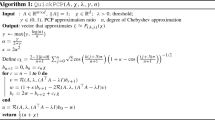Abstract
Principal Component Analysis (PCA) has been implemented by several neural methods. We discuss a Network which has previously been shown to find the Principal Component subspace though not the actual Principal Components themselves. By introducing a constraint to the learning rule (we do not allow the weights to become negative) we cause the same network to find the actual Principal Components. We then use the network to identify individual independent sources when the signals from such sources are ORed together.
Similar content being viewed by others
References
T.D. Sanger, “Analysis of the two-dimensional receptive fields learned by the generalized hebbian algorithm in response to random input”, Biological Cybernetics, 1990.
E. Oja, H. Ogawa and J. Wangviwattana, “Principal component analysis by homogeneous neural networks, part 1: The weighted subspace criterion”, IEICE Trans. Inf. & Syst., E75-D:366–375, May 1992.
C. Jutten and J. Herault, “Blind separation of sources,part 1: An adaptive algorithm based on neuromimetic architecture”, Signal Processing, Vol. 24, pp. 1–10, 1991.
A.J. Bell and T.J. Sejnowski, “An information maximization approach to blind separation and blind deconvolution”, Neural Computation, Vol. 7, pp. 1129–1159, 1995.
J. Karhunen and J. Joutsensalo, “Representation and separation of signals using nonlinear pca type learning”, Neural Networks, Vol. 7, No. 1, pp. 113–127, 1994.
M. Girolami and C. Fyfe, “Stochastic ica contrast maximisation using oja's nonlinear pca algorithm”, International Journal of Neural Systems, 1997.
M. Girolami and C. Fyfe, “A temporal model of linear anti-hebbian learning”, Neural Processing Letters, 1997 (in press).
C. Fyfe, “Pca properties of interneurons”, in From Neurobiology to Real World Computing, ICANN 93, pp. 183–188, 1993.
E. Oja, “Neural networks, principal components and subspaces”, International Journal of Neural Systems, Vol. 1, pp. 61–68, 1989.
P. Földiák, Models of Sensory Coding, PhD thesis, University of Cambridge, 1992.
E. Saund, “A multiple cause mixture model for unsupervised learning”, Neural Computation, Vol. 7, pp. 51–71, 1995.
P. Dayan and R.S. Zemel, “Competition and multiple cause models”, Neural Computation, Vol. 7, pp. 565–579, 1995.
R.H. White, “Competitive hebbian learning: Algorithm and demonstration”, Neural Networks, Vol. 5, pp. 261–275, 1992.
L. Xu, E. Oja and C.Y. Suen, “Modified hebbian learning for curve and surface fitting”, Neural Networks, Vol. 5, pp. 441–457, 1992.
J. Karhunen, E. Oja, L. Wang, R. Vigário and J. Joutsensalo, “A class of neural networks for independent component analysis”, IEEE Transactions on Neural Networks, 1997 (in press).
L. Wang and J. Karhunen, “A unified neural bigradient algorithm for robust pca and mca”, International Journal of Neural Systems, 1995.
Author information
Authors and Affiliations
Rights and permissions
About this article
Cite this article
Fyfe, C. A Neural Network for PCA and Beyond. Neural Processing Letters 6, 33–41 (1997). https://doi.org/10.1023/A:1009606706736
Issue Date:
DOI: https://doi.org/10.1023/A:1009606706736




